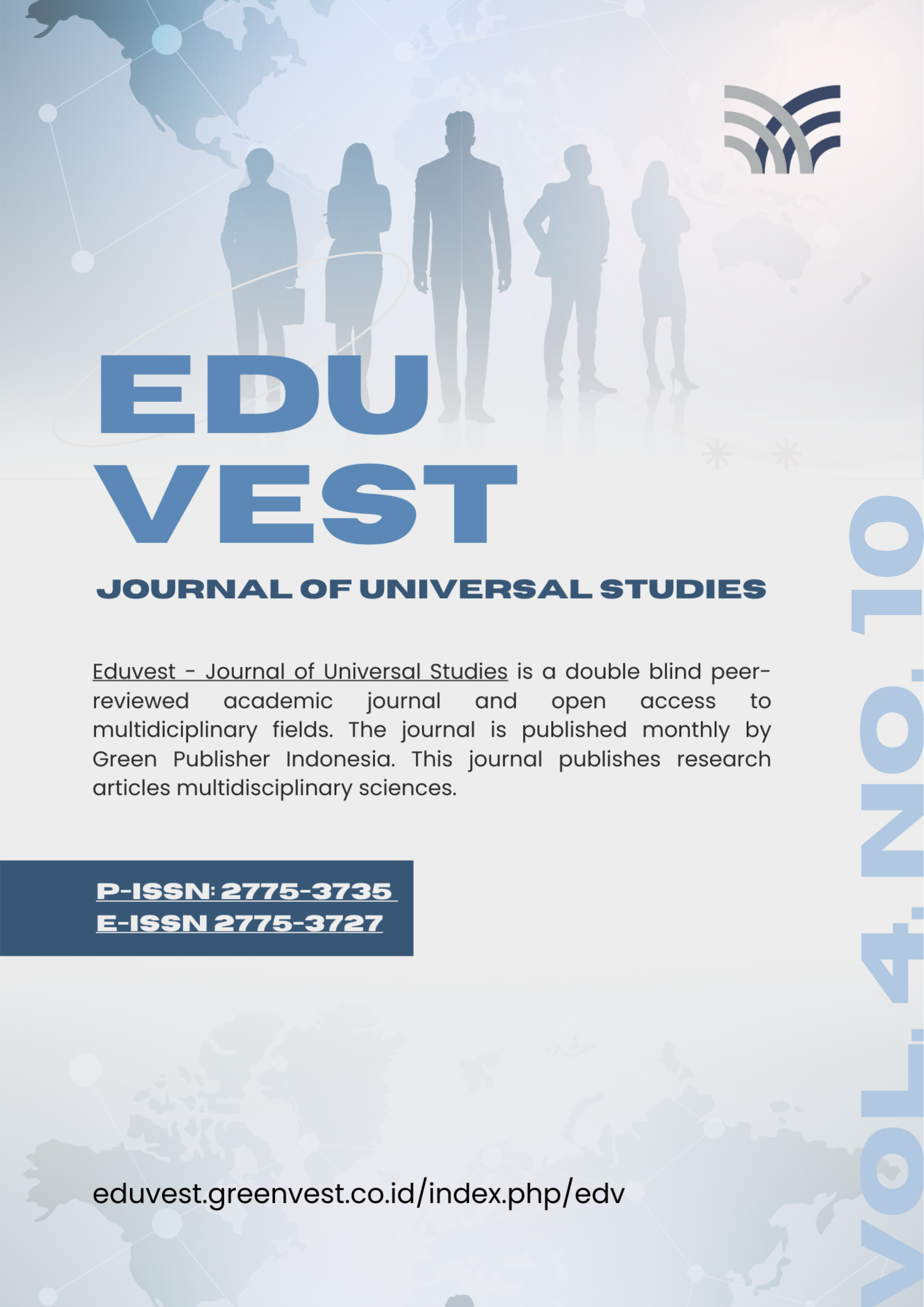The Validity and Reliability of Self-Assessment on Reading Comprehension at Junior High School
DOI:
https://doi.org/10.59188/eduvest.v4i10.1386Keywords:
Validity, Reliability, Self-AssessmentAbstract
This study aims to investigate whether self-assessment is valid and reliable for assessing reading comprehension. Participants in this study were 18 male students and 20 female students from a junior high school. This research is quantitative research designed with mixed methods, causal-comparative and correlative research. Independent t test was used to analyse validity, and correlation analysis was used to test reliability. Researchers used two instruments in the data collection process, (1) a self-assessment questionnaire and (2) a reading comprehension test. This research concludes that 1) self-assessment is valid because male and female students do not carry out self-assessment differently. This means that gender is not a construct irrelevance factor that affects the validity of self-assessment. 2) Self-assessment is reliable or consistent because there is a positive correlation between self-assessment scores and reading comprehension tests. Two statistical analyses were used to examine the data collected. First, independent t-tests were used to investigate the influence of gender on self-assessment scores. From data analysis, this study revealed that there were no significant differences between male and female students in self-assessment. This means that gender is not proven to be an irrelevant factor to the construct that affects validity. Thus, the self-assessment of reading comprehension in junior high school is valid.
References
Boud, D. (1995). Enhancing Learning through Self Assessment. Taylor & Fancis.
Brown, H. D. (2003). Language Assesment Principles and Classroom Practice. In Pearson Longman.
Chang, C. C., Liang, C., & Chen, Y. H. (2013). Is learner self-assessment reliable and valid in a Web-based portfolio environment for high school students? Computers and Education, 60(1), 325–334. https://doi.org/10.1016/j.compedu.2012.05.012
Falchikov, N., & Boud, D. (1989). Student Self-Assessment in Higher Education: A Meta-Analysis. Review of Educational Research, 59(4). https://doi.org/10.3102/00346543059004395
Langan, A. M., Shuker, D. M., Cullen, W. R., Penney, D., Preziosi, R. F., & Wheater, C. P. (2008). Relationships between student characteristics and self-, peer and tutor evaluations of oral presentations. Assessment and Evaluation in Higher Education, 33(2). https://doi.org/10.1080/02602930701292498
Lesmana, N., & Rokhyati, U. (2020). The Implementation of Doing Self-Assessment in Higher Education. Journal of English Language Studies, 5(1), 60–72. https://doi.org/http://dx.doi.org/10.30870/jels.v5i1.7210
Lianisa. (2014). The Use of Self-Assessment toward Students’ Reading Behavior (A Case Study). Journal of English and Education, 2(2), 26–35. https://ejournal.upi.edu/index.php/L-E/article/view/4606
Matsuno, S. (2009). Self-, peer-, and teacher-assessments in Japanese university EFL writing classrooms. Language Testing, 26(1), 075–100. https://doi.org/10.1177/0265532208097337
McAndrews, S. L. (2020). Literacy Assessment and Metacognitive Strategies: A Resource to Inform Instruction, PreK-12. Guilford Press, 508. http://login.ezproxy1.lib.asu.edu/login?url=https://www.proquest.com/books/literacy-assessment-metacognitive-strategies/docview/2488225891/se-2?accountid=4485
Mistar, J. (2011). A Study of The Validity and Reliability of Self-Assessment. TEFLIN Journal, 22(1), 45–58. https://eric.ed.gov/?id=EJ1129982
Newton, P. E., & Shaw, S. D. (2014). Validity in Educational & Psychological Assessment. In Validity in Educational & Psychological Assessment. https://doi.org/10.4135/9781446288856
Nourdad, N., & Asghari, R. (2017). The Effect of Reflective Reading on Reading Comprehension of Iranian EFL Learners. International Journal of Applied Linguistics and English Literature, 6(6). https://doi.org/10.7575/aiac.ijalel.v.6n.6p.267
Permata, I., Selutan, S., Sutapa, G., & Rosnija, E. (2015). The implementation of self-assessment in teaching reading comprehension on narrative text. Jurnal Pendiidkan Dan Pembelajaran, 4(11), 1–11. http://jurnal.untan.ac.id/index.php/jpdpb/article/view/12487
Race, P. (2001). A Briefing Document on Self, Peer and group Assessment. 9.
Ross, J. A. (2006). The Reliability, Validity, and Utility of Self-Assessment. Practical Assessment, Research and Evaluation, 11(10). https://doi.org/https://doi.org/10.7275/9wph-vv65
Shameem, N. (1998). Validating self-reported language proficiency by testing performance in an immigrant community: The Wellington Indo-Fijians. Language Testing, 15(1), 86–108. https://doi.org/10.1177/026553229801500104
Sung, Y. T., Chang, K. E., Chiou, S. K., & Hou, H. T. (2005). The design and ap-plication of a web-based self- and peer-assessment system. Computers and Education, 45(2), 187–202. https://doi.org/10.1016/j.compedu.2004.07.002
Vasileiadou, D., & Karadimitriou, K. (2021). Examining the impact of self-assessment with the use of rubrics on primary school students ’ perfor-mance. International Journal of Educational Research Open, 2–2(January), 100031. https://doi.org/10.1016/j.ijedro.2021.100031
Yan, Z., Brown, G. T. L., Lee, J. C., Qiu, X., Yan, Z., Brown, G. T. L., Lee, J. C., & Qiu, X. (2019). Student self-assessment : why do they do it ? Educational Psychology, 0(0), 1–20. https://doi.org/10.1080/01443410.2019.1672038
Soesilo, T. D. (2018). Penelitian Inferensial dalam Bidang Pendidikan. Salatiga: Satya Wacana University Press.
Boud, D. (1995). ENHANCING Self Assessment. 239.
Brown, H. D. (2003). Language Assesment Principles and Classroom Practice. In Pearson Longman.
Falchikov, N., & Boud, D. (1989). Student Self-Assessment in Higher Education: A Meta-Analysis. Review of Educational Research, 59(4). https://doi.org/10.3102/00346543059004395
Langan, A. M., Shuker, D. M., Cullen, W. R., Penney, D., Preziosi, R. F., & Wheater, C. P. (2008). Relationships between student characteristics and self-, peer and tutor evaluations of oral presentations. Assessment and Evaluation in Higher Education, 33(2). https://doi.org/10.1080/02602930701292498
Lianisa. (2014). The Use of Self-Assessment toward Students’ Reading Behavior (A Case Study). Journal of English and Education, 2(2), 26–35.
Matsuno, S. (2009). Self-, peer-, and teacher-assessments in Japanese university EFL writing classrooms. Language Testing, 26(1), 075–100. https://doi.org/10.1177/0265532208097337
Ross, J. A. (2006). The Reliability, Validity, and Utility of Self-Assessment. Practical Assessment, Research and Evaluation, 11(10).
Yan, Z., Brown, G. T. L., Lee, J. C., Qiu, X., Yan, Z., Brown, G. T. L., Lee, J. C., & Qiu, X. (2019). Student self-assessment : why do they do it ? Educational Psychology, 0(0), 1–20. https://doi.org/10.1080/01443410.2019.1672038
Published
How to Cite
Issue
Section
License
Copyright (c) 2024 Irfan Susiyana Putra

This work is licensed under a Creative Commons Attribution-ShareAlike 4.0 International License.











